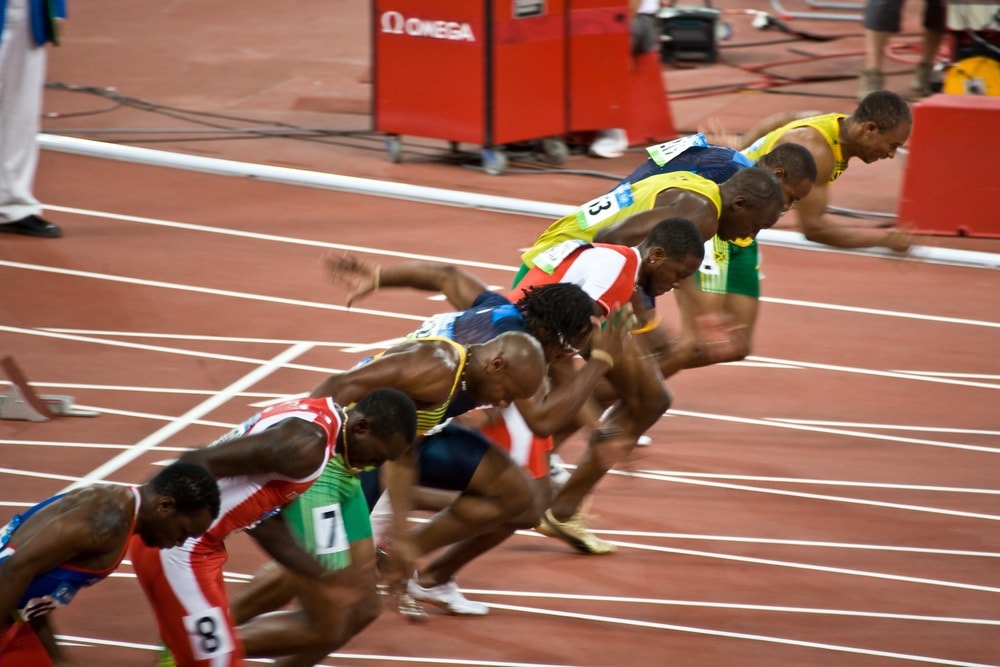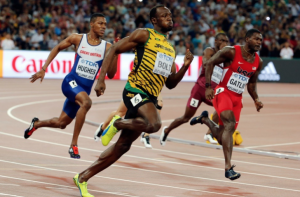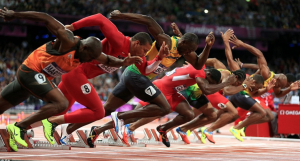Push or Pull? Sprinting Mechanics and You

Evan Stevens
One of the comments that I received after last weekend’s UWO Health and Wellness Symposium was what it meant to be a “push or pull sprinter.” This comes from a comment that Mr. Andy O’Brien made during his Developing a Body for Sport and Life about how every athlete is different – that a push sprinter will train slightly different than a pull sprinter and vice versa. While I had a general idea of the difference, when I pressed myself about it I found I really didn’t know the difference. Coming from a distance background, sprinting mechanics are slightly foreign to me. I know the basics and how to get out of blocks in a reasonable fashion, but this was the first time I too had heard of push and pull sprinters. This would take some digging.
Want to know exactly what you need to eat to perform and feel better, lose weight, end cravings and have more energy? Check out the Viome gut microbiome and wellness kit.
Push Sprinting
Push sprinting is the action of actively driving the foot down from a hip extension. The gluteus maximus is seen as the main driver for forwarding movement in push sprinting and begins the moment the foot starts to make movement back to the ground. This means that the leading leg cannot be left to just “fall” back down to the ground, it needs to be pushed down. The thinking behind this is that it allows the foot to go through its full range of motion and set up the trigger motion, better allowing the foot to dorsiflex up and trigger the next stride. While keeping an eye on your heart rate.
Related Article: It’s All In The Hips
 Looking to track your fitness and other health stats in a minimal, stylish way? Try the Motiv Fitness Ring.
Looking to track your fitness and other health stats in a minimal, stylish way? Try the Motiv Fitness Ring.
Pull Sprinting
Pull sprinters do not care so much about the gluteus maximus’ role in driving the foot down – gravity does that. The gluteus maximus is good for stabilizing and keeping your hips straight and center, where they should be, but the importance of the stride comes from pulling the leg up off the ground. Pull sprinters make efficient use of gravity to drive their legs down so they have more energy to pull their legs back up and into the next stride. This pull is supposed to be the only part of the stride that requires any actual energy – conserving energy to make each pull as powerful and as snappy as possible.

Above: Usain Bolt (Jamaica – Centre) with full pull stride running against Justin Gatlin (USA – far Right). Notice Bolt’s trail leg is right up to his glute (typical of a pulling motion) whereas Gatlin’s is lower but already starting his follow-through to his next stride (typical of a push stride). Also notice how Bolt is more upright but Gatlin is more pitched forward, again typical of the two different stride types.
Now that we have an idea of the differences between pushing (forcing your leg down) and pulling (letting gravity drop the leg and forcefully pulling the leg back up), how can you tell what kind of sprinter you are? The truth is, there is no easy way to do it. Unless a coach knows what they are looking for and are highly experienced, they won’t be able to notice some of the finer movements. The most concrete way to look at how you run is to put sensors on your working muscle groups, hook you up to a machine that charts neuromuscular and electrical activation, and see what muscles are activated at what part of each stride. Costly and time-consuming.
Generally,
these push sprinters will plant their foot under or even slightly behind the hips during a full stride. Push sprinters generally need to pitch themselves slightly forward because if they force their foot down and make ground contact too early (landing ahead of their body), it can lead to feet being on the ground for too long and cause slower running times.
Push sprinters also tend to not lift their legs towards their glutes as much as pull sprinters when bringing their leg back in front of them. Pull sprinters tend to run a little more upright than push sprinters as they plant their foot directly under their hips more so than push sprinters. They also seem to snap their legs back up to their glutes when they bring their legs back in front of them because they are pulling them up and out. So, if you find yourself leaning forward and keep your head down a little longer than the competition, you might be a push sprinter. If you drive with your knee, and kick your butt, you are more of a pull sprinter.
 For post-running recovery and muscle soothing, check out the amazing Recoup Fitness Roller, which combines massage and cold therapy technologies.
For post-running recovery and muscle soothing, check out the amazing Recoup Fitness Roller, which combines massage and cold therapy technologies.
Problem
Sprinting (or proper sprinting form) is both a pushing and a pulling action. Sprinters use both the front and back of their legs to push and pull themselves along the track. You can also see this in their upper bodies – sprinters are well muscled through their chest, back, shoulders, and arms in muscles groups seen in either a pushing or a pulling action. Focusing on a pull movement for push sprinters and a push technique for pull sprinters will help to make a better all-around sprinter. Coaches need to recognize that each athlete is different – each athlete has a running style that they have come to because it is most efficient for them. Focusing on the push movement for push sprinters is going to leave them weak at pulling their leg up – this can lead to a lot of hamstring problems that we see in sprinters.
The hamstring is hugely important for the pulling motion; if they take on too much effort when a push sprinter is tired, they are prone to injury. Same can be said for pull sprinters and their hips; hip flexors are important for the push technique and when trying to generate power, say out of the blocks, if not properly trained, the sprinter can strain their hip flexors pretty easily. Coaches need to be able to be able to recognize that different training methods may be required for different athletes.
Related Video: Train Like A Master Sprinter
The need for both techniques is demonstrated by physics and forces. Lately, there has been some controversy over the advantage of the pull technique. The pull bringing the leg up is a vertical movement; gravity is a vertical force down. How do these vertical forces translate into horizontal movement? Getting the foot off the ground quickly is important, but if no propulsion force is generated a sprinter isn’t going to go anywhere. Sprinters with a fast cadence but low force aren’t going to get anything from practicing a pull technique. Yet excessive focus on pushing can cause sprinters to spend too much time on the ground (beginner sprinters especially), as they will get their feet down too early (thus the need to pitch forward more to keep their feet moving to catch themselves from falling) which can lead to overstriding and a slow cadence.
Enhance the intensity of your workout with HyperWear Gear and save space with their SandBell Weights.

Notice the different running techniques above. Both push and pull on full display. Notice the demonstration of vertical force that can be used in both a push and pull in technique in the lead athlete.
Remember
There is no optimum way to run, each runner already has an optimum way to run inside them. Push sprinters are not better than pull sprinters. Both styles need to practice the other to become better all-around runners. Fast legs, dorsiflexing your foot, planting under your hips or slightly behind your body, driving with your knees and pushing off with force are what make a good runner. When doing drills such as your A’s and B’s it is important to be aware of both the push and pull actions.
Forcefully pushing your legs down to contact the running surface but pulling them back up quickly to get into the next stride. Bringing your legs back towards your glutes in a snappy motion when doing lunges; driving with your knees when doing your warm-up strides, and working on both the front and back of your hips and legs are going to make you a better sprinter. Next time you are at the track and doing your pre-workout drills try focusing on just one aspect of each technique during each drill set.
Related Video: Sled Pulls with Master Sprinter Tunde Ridley














